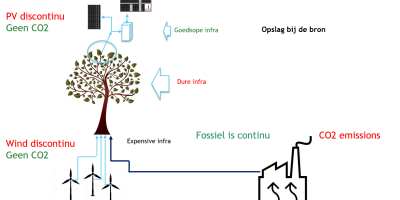Mismatch in energy generation and usage
The roof (and if necessary the facade) of a LiveFree house contains integrated solar panels. They provide every house with more than enough energy needed in one year . However, there is a mismatch between generating and using energy. Both between day and night and between summer and winter . For that we need a day storage and a season storage system for energy. A season storage is too expensive when using Li-ion battery technology . LiveFree can provide alternatives with no dependency on fossil fuel and so become the first supplier of CO2-neutral Houses
Season storage
True CO2 neutral living is only possible with season storage

Energy storage
We can apply different configurations of energy storage in our energy unit. The basic need is a day-storage system to cope with the day and night rhythm of using and generating energy. The average consumption is 10 KWh per day based on a 3600 KWh yearly use . However with a full-electric-house this day usage is much more in the winter. The reason is the heat-pump which is doubling the day use. For that reason we need to use the heat-pump as much as possible during the day and use the heat generated during the day in the evening . A buffer tank is capable of providing that function. In our houses the buffer tank can even keep the house warm for more than 6 days.
Traditional storage systems use mainly Li-ion batteries or heat carrying mediums like water to store energy. When material changes it phase i.e. water changes to ice or paraffin(suet) to f.i. a candle it can absorb and release more energy . We can provide such systems but they are inadequate for storing enough energy to cover the season gap. The only technology which is promising is Hydrogen.
Hydrogen has always been a promising technology but never matured.
The reason being that fuel-cells have been sensitive for polluted hydrogen generated by fossil fuels and large cells are expensive. On top of that storage is expensive and perceived as dangerous. For domestic use this is different we generate our pure hydrogen with electrolysers and use very small fuel-cells 2 Kw max and have the storage relative remote. The combination between day and season storage makes this possible. The relative small fuel-cell keeps the day-storage on level in the wintertime and does not have to provide the large power levels during electrical cooking or other demanding electrical domestic appliances.
For season storage we need minimal 1500 KWh storage in electricity. When we combine day-storage based on Li-ion max 10 KWh and Season-storage based on Hydrogen and heat storage based on a warm water buffer-tank we have the ideal combination. Today the cost price of Li-ion batteries is about 400 Euro per KWh . With hydrogen we can come down to 40 Euro per Kwh and a buffer-tank cost about 100 euro per KWh heat storage. We need however a certain amount of power when cooking or using other equipment which determines the size of the expensive Li-ion battery.
Hydrogen Season storage
The only way to create independence from fossil fuel
The hydrogen storage is placed remotely from the houses. A natural gas piping infrastructure is used to transport the hydrogen to the bi-directional fuel-cell where it is converted to electricity and stored in the day-storage battery for later use. In the summer the fuel-cell operates as an electrolyser and produces hydrogen which is stored in the hydrogen tanks via a solid state compressor.
